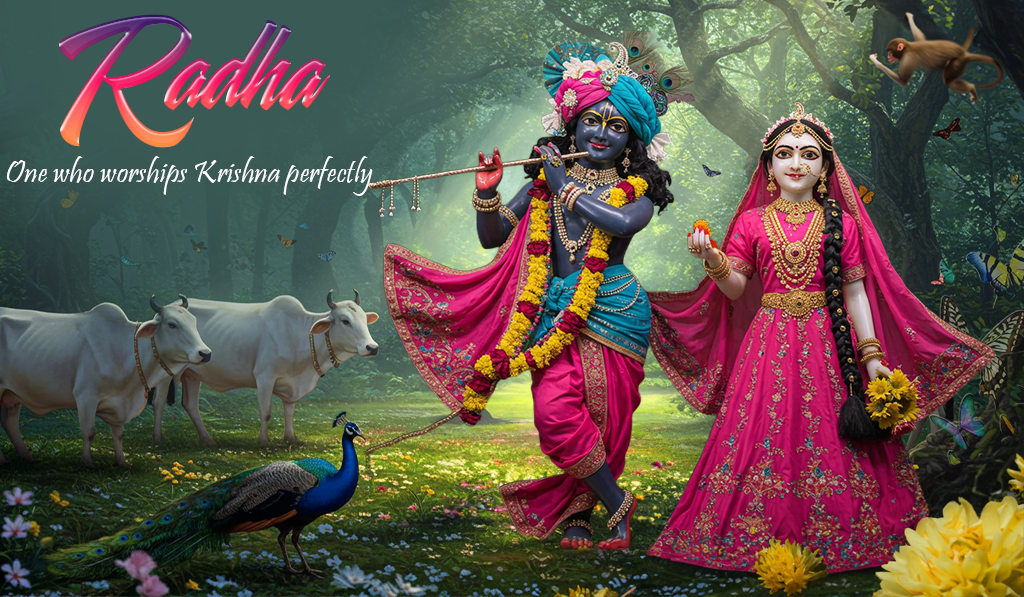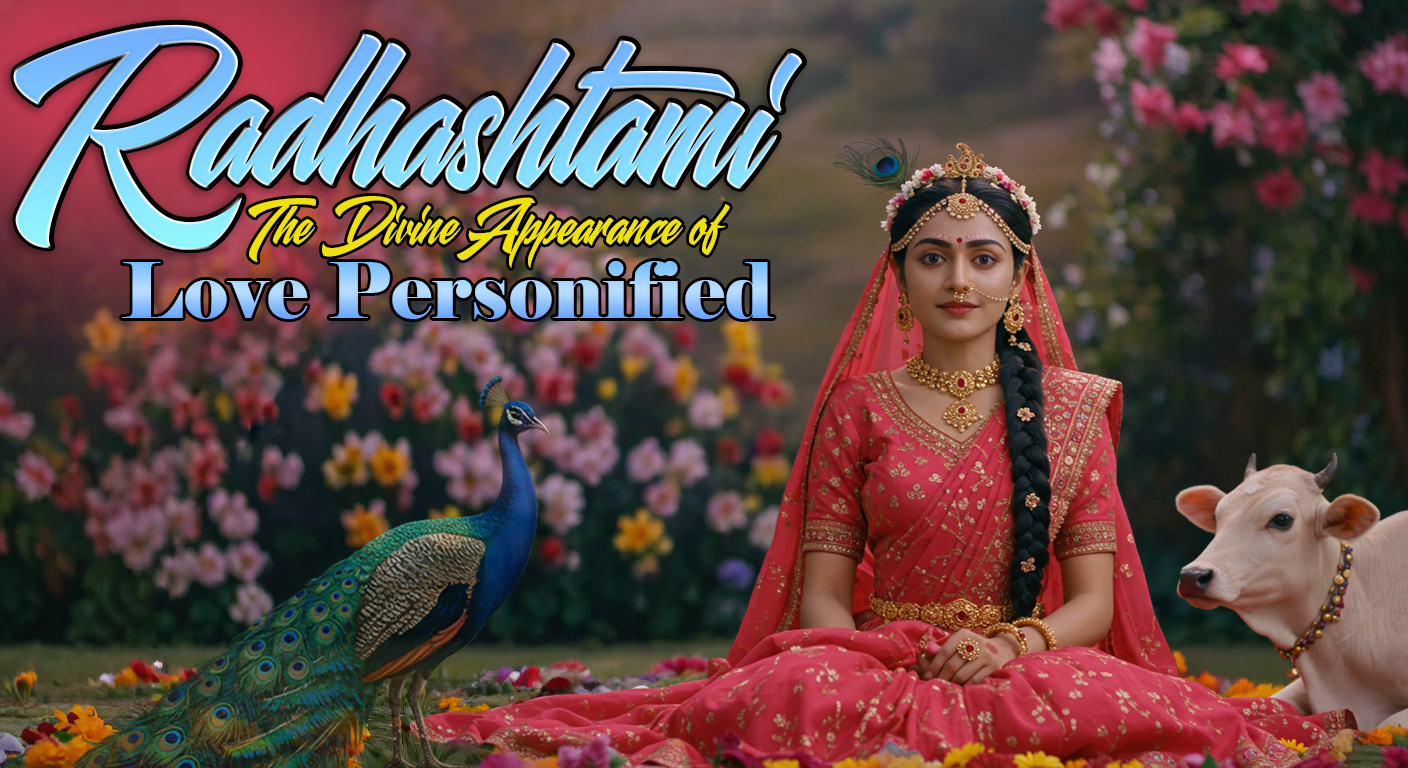The meaning of “Radha” –One who worships Krishna perfectly.
In the spiritual tradition, Radha is not merely a name but a symbol of the highest form of Bhakti –devotion. The very etymology of “Radha” is deeply significant. Derived from the Sanskrit root “radh”, it means to worship, to attain or to be successful in devotion. Thus, Radha represents one who worships Krishna in the most complete and perfect manner.
Engaging in pure, devotional love
The love between Radha and Krishna is depicted not as worldly attachment but as the soul’s eternal longing for union with the Divine. Radha’s devotion is selfless, untainted by desire for reward or recognition. Her worship is pure surrender, making her the epitome of para-bhakti—the supreme form of devotion that transcends rituals and merges into unconditional love. The Gita Govinda by Jayadeva beautifully portrays this divine love, showing Radha’s surrender, humility, and unwavering faith.
ananyāś cintayanto māṁ ye janāḥ paryupāsate
teṣāṁ nityābhiyuktānāṁ yoga-kṣemaṁ vahāmy aham”
(Bhagavad Gita 9.22)
Krishna declares that those who worship Him with undivided devotion are constantly protected and sustained by Him. Radha embodies this principle—her devotion is single-pointed (ananya-bhakti), with no expectation but Krishna Himself.
Eternal love
Srimati Radharani is described as the internal potency or eternal consort of Lord Krishna. She is specifically identified as Krishna’s hladini sakti, or His pleasure potency, eternal consort.In many traditions, Radha is considered even higher than Krishna in devotion, because she demonstrates how the human soul should love the Divine—fully, sincerely, and without self-interest. Her separation (viraha) from Krishna is as sacred as her union, for it intensifies longing and keeps the flame of devotion alive.
Reference in the Scriptures
Though Radharani’s name is not directly mentioned in the Bhagavad-gita, Srila Prabhupada indicates an indirect mention in the explanation of the verse “mahatmanas tu mam partha daivim prakritim asritah,” where daivim prakritim asritah refers to pure devotees taking shelter of the para prakrti, the internal potency of the Lord called Lakshmidevi, Sitadevi, Srimati Radharani or Srimati Rukminidevi.
In the Bhagavatam too there is not direct mention of Radharani’s name because if Sukadev Goswami had mentioned Her name he would not be able to complete his recitation of Srimad Bhagavatam; he would have been lost in an ecstatic mood! Therefore there is only one place that Radharani’s name is mentioned and that too indirectly. ―Truly the Personality of Godhead has been worshiped by Her. Therefore Lord Govinda, being pleased, has brought Her to a lonely spot, leaving us all behind.
(Srimad-Bhagavatam 10.30.28.)
e Bhagavatam too there is not direct mention of Rad
Understanding Krishna as He is
Srimati Radharani’s life is a reminder that the truest worship lies not in rituals alone but in offering one’s heart, thoughts, and actions completely to God. To chant Krishna’s name as Radha did, to see Him in all beings and to live in constant remembrance of Him is the path of perfect Bhakti.
(Bhagwad Gita 18.55)
Connection to the Maha-Mantra
The Hare Krishna maha-mantra, “Hare Krishna, Hare Krishna, Krishna Krishna, Hare Hare/ Hare Rama, Hare Rama, Rama Rama, Hare Hare,” is described as a plea to the internal potency (Hare, representing Radharani) to be engaged in Krishna’s service. We worship Radha with Krishna, because She is the dearest devotee of Krishna and by pleasing Her we can also become dear to Him.
(Inquiries Into The Absolute by Rompada Swami)
By bestowing devotion, she enables the small soul to connect with the greatest soul, Krishna and thereby become great – not in size, but in influence. Krishna uses the souls devoted to him as instruments for his infinite power, wisdom and compassion to appear and act in this world.
(Bhagwad Gita 9.13)
The Ideal Devotee
“yo mad-bhaktaḥ sa me priyaḥ”
(Bhagwad Gita 12.14)
Krishna lists the qualities of His most beloved devotees: free from envy, compassionate, forgiving, selfless, steady, and fully surrendered. Radha’s life mirrors these qualities perfectly, making her the eternal Priya Bhakta (dearest devotee).
Thus, Srimati Radharani is not just Krishna’s beloved—she is the very personification of devotion. She teaches us that to worship God perfectly is to love Him unconditionally, serve Him sincerely and surrender the self entirely.
harani’s name because if Sukadev Goswami had mentioned Her name he would not be able to complete his recitation of Srimad Bhagavatam; he would have been lost in an ecstatic mood! Therefore there is only one place that Radharani’s name is mentioned and that too indirectly. ―Truly the Personality of Godhead has been worshiped by Her. Therefore Lord Govinda, being pleased, has brought Her to a lonely spot, leaving us all behind.
(Srimad-Bhagavatam 10.30.28.)





